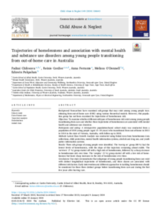Abstract
Background
Researchers have examined sub-groups that may exist among young people transitioning from out-of-home care (OHC) using various theoretical models. However, this population group has not been examined for trajectories of homelessness risk.
Objectives
To examine whether different subtypes of homelessness risk exist among young people transitioning from care and whether these trajectories of homelessness are associated with mental health and substance use disorders.
Participants and setting
A retrospective population-based cohort study was conducted from a population of 1018 young people (aged 15–18 years) who transitioned from out-of-home in 2013 to 2014 in the state of Victoria, Australia, with follow-up to 2018.
Methods
Latent Class Growth Analysis was conducted using linked data from homelessness data collections, child protection, mental health information systems, alcohol and drug use, and youth justice information systems.
Results
Three sub-groups of young people were identified. The ‘moving on’ group (88 %) had the lowest levels of homelessness, with the slope of this trajectory remaining almost stable. The ‘survivors’ (7 %) group started off with a high risk of homelessness, followed by a sharp decrease in homelessness risk over time. The ‘complex’ (5 %) group started off with a low risk of homelessness but faced sharp increases in the risk of homelessness over time.
Conclusions
This study demonstrates that subgroups of young people transitioning from care exist with distinct longitudinal trajectories of homelessness, and these classes are associated with different risk factors. Early intervention and different approaches to tackling homelessness should be considered for these three distinct groups before transitioning from care and during the first few years after leaving care.

